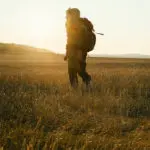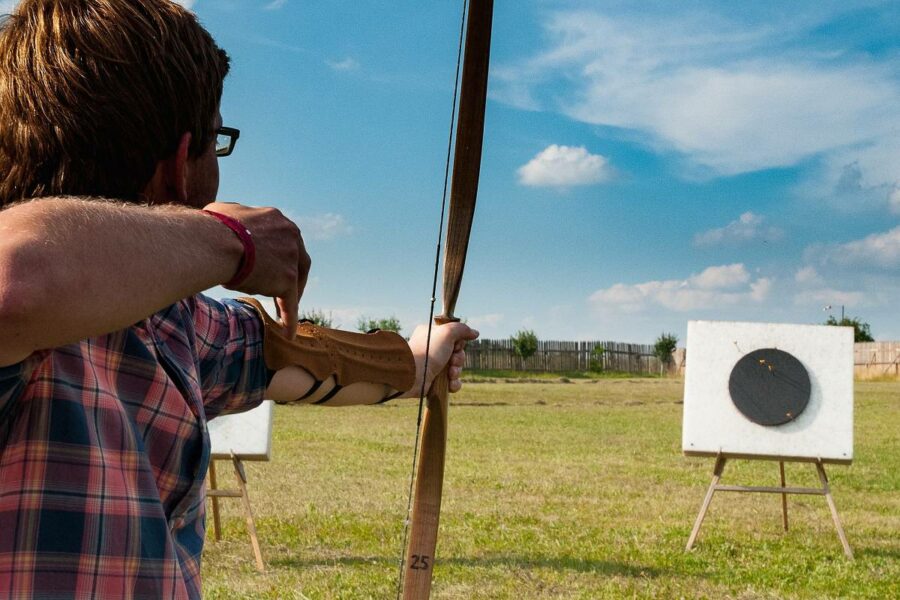Spending your free time outside is truly valuable to both kids and adults alike. But after you grow up, you can’t just run around the backyard playing with toys and your friends. Well, there is one exception, one toy that can transform into a tool you can use for hunting, sport, or just for goofing around, and that’s the bow.
The bow symbolizes the human ability to adapt and thus invent timeless creations that get replaced by improvements in the coming years. But those tools do remain in people’s lives, they just aren’t that prominent.
And today, we will be looking at just what exactly makes a certain type, so special, the takedown recurve bow, and what are the best models, both traditional and ones made for hunting and sports archers.
1. Samick Sage Takedown
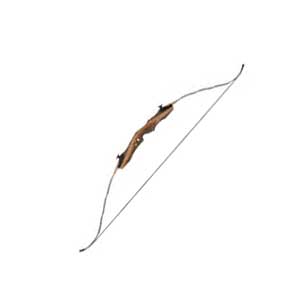
From Samick Sage, we have an excellent first entry that is not only very accessible, with an easy-to-adapt ambidextrous design, but it is also made with a great amount of craftsmanship, allowing it to look as amazing as it functions.
It is easy for your pocketbook to suffer as you descend the recurve weapons rabbit hole. One can waste hundreds of dollars when the truth is that the Sage is all you need for a shooting lifetime. The weight at the draw starts at 25 lbs. But it can grow to about 60 lbs as your know-how goes from amateur to expert.
The riser (grip segment in the middle) and the limbs are made of laminated wood, which provides a good grip, and smooth pull and minimizes vibration. When fired, it’s quiet, so you don’t alert your prey or annoy other people at your favorite range. It accepts lots of fittings for a personalized experience.
Pros
- It has a simple-to-adjust ambidextrous nature
- The draw weight begins at 25 lbs but can expand to 60 lbs
- The riser and the limbs are made of laminated wood, which provides a good grip, and smooth drawing and reduces the noise to a minimum
Cons
- The item overall looks on the cheaper side and leaves a lot to be done
2. SinoArt Falcon 60″ Takedown
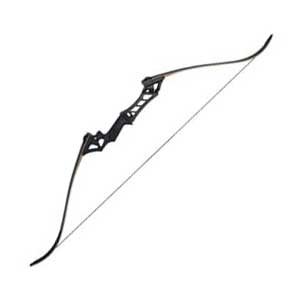
SinoArt Falcon 60″ Takedown excels not only in the cosmetic but also in the quality department. It has an alloy handle that gives it rigidity but also a premium look, a long and decently curved body, and string holders that will allow a precise and fast shot without much hassle.
The whole body can be summed up in two words, elastic and rigid. the double-layer wood limbs attached to the anodized machined aluminum body give it a distinct meaty and powerful feeling in the hand that makes it a little bit more unique than its competition.
As for size, it’s a pretty standard affair that gives it enough power to not only hunt but also practice in your backyard. you can choose from a variety of colors and match the riser and the limbs or the opposite or make them different for a more unique look.
The draw weight is very adjustable, and the item itself is pretty light, so on-the-fly adjustment and use are as easy as pie. Suffice it to say, if you are looking for something light and fast but accurate and powerful, don’t hesitate and get this bow.
Pros
- It has an alloy handle that gives it rigidity but also a premium look
- A long and decently curved body and string holders will allow for a
- precise and fast shot without much of a hassle
- Its size gives it enough power to not only hunt but also practice in your backyard
Cons
- The handle is pretty high quality, but that is not the same for the limbs
3. KESHES Hunting
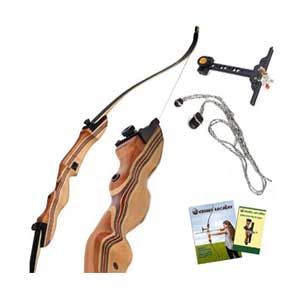
Keshes appears on this list with a rare breed of takedown recurve bows, one that can crank down the draw weight down to 15 from the pretty good for the class 55 pounds. And what about that makes it so special? Well, if you are a teen or you just want to get your kid interested in archery, the broad range of draw weights allows the product to be used all the way from a beginner level to an intermediate.
But that isn’t the only good thing about the Keshes. It comes with a large array of tools and a couple of accessories like a stringer and a scope, so you can start shooting right away without much preparation. Overall, for the price and for the unique features it presents, this weapon has its own niche in the market that make it the best choice for what it does.
Pros
- If you are a teen, or you just want to get your kid interested in archery, the broad range of draw weights allows it to be used all the way from a beginner level to an intermediate
- It comes with a large array of tools and a couple of accessories like a stringer and a scope
Cons
- While it is a very good product that has a lot of work put into it, it is aimed at a very niche market, which is a huge problem
4. Southwest Archery Samick Sage
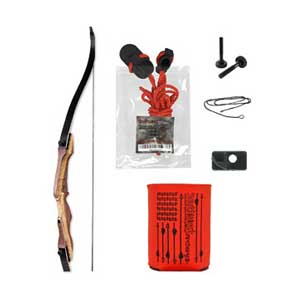
The Southwest Archery’s Samick Sage is an excellent all arounder with premium materials and feel and a great company name behind it, so you know exactly what you are. You can also rest assured that upgrading will be as easy as pie, with preinstalled brass bushings and a plunger to adapt easily to new parts.
As for the design, the bow comes with not only metal alloy but also limbs that are coated with an ack laminate to make it elastic and strong but also stylish and minimalistic. As for the overall look, it looks modern while also following traditions, so you will get something in-between that will look stylish almost anywhere,
To wrap it up, with the fact that it is well made, good looking, and easy to use and learn to appreciate, if you are a fan of the brand, go ahead and order it right now, you won’t be disappointed even a bit.
Pros
- It is an excellent all arounder with premium materials and fell and a great company name behind it
- The preinstalled brass bushings and plunger are made to adapt easily to new parts
- The Samick Sage comes with not only metal alloy but also limbs that are coated with a thick laminate to make it elastic and strong but also stylish and minimalistic
Cons
- It is very weak in the limbs, and after only a couple of uses, it can twist on you very badly, making the bow unusable
5. Southwest Archery Snyder
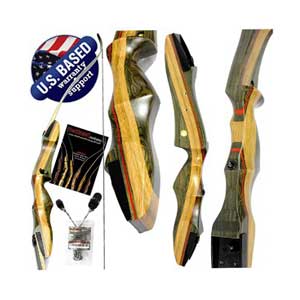
Using the original Samick sage design, The Snyder utilizes a plethora of different wood materials to make a compound that is not only lightweight and strong but also pretty good-looking too.
It’s ambidextrous, so it is accessible for all that can handle it, but that is also a pretty large pool of people because the draw weight can easily be increased all the way from 20 to 60 pounds with 5-pound increments, which makes it a leader when it comes to accessibility.
The Snyder also features preinstalled threaded bushings for various accessory upgrades such as mechanical rests/plungers, sights quivers, and stabilizers for the fishing reels. The limb tips are reinforced, giving a fast shot perfect for both hunting and fishing and backyard practice.
But it doesn’t end here because this item includes one handcrafted riser LH or RH, one pair of matching upper and lower limbs, 14-strand Dacron string, one stick-on adhesive arrow rest, and detailed step-by-step instructions with photos. This model is a new, improved version and an award-winning for 2018, rated the perfect kit for beginners interested in Olympic recurved wooden bows.
Pros
- The Snyder utilizes a plethora of different wood materials to make a compound that is not only lightweight and strong but also pretty good looking too
- It’s ambidextrous, so it is accessible for all that can handle it, and this is a large pool with its adjustable draw weight
- Features preinstalled threaded bushings for various accessory upgrades
Cons
- The overall quality is pretty acceptable, but the lamination on the wood is pretty prone to cracking, and thus it leaves the limbs prone to twisting
6. Toparchery Archery 56″
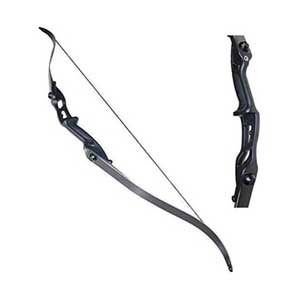
Compared to most of its competitors on this list, Toparchery Archery 56″ is a few inches shorter, but that doesn’t make it even a bit worse. It is black, making it stylish and good-looking, and the aluminum riser brakes the black limbs in half, making a very simplistic and smart-looking bow. The arms are made of industrial-grade fiberglass coating around a hard maple core, giving them rigidity and elasticity.
It has a pretty decent draw weight range, from 30 to 50 pounds and the draw length is also pretty adjustable so that accessibility won’t be a problem. It also comes with a case and an arrow rest, so the package isn’t just an item in a ziplock bag, it is packaged very well.
To end things, with a good polish and a very well-made design, this product manages to hit all the right marks while also having a reasonable price, making it affordable.
Pros
- It is black, making it stylish and good-looking, and the aluminum riser brakes the black limbs in half, making a very simplistic and smart-looking
- It has a pretty decent draw weight range, from 30 to 50 pounds and the draw length is also pretty adjustable
- Toparchery Archery 56″ also comes with a case and an arrow rest, making it a complete and actually very good package
Cons
- The fact the whole item is a little bit too short makes it a lot more prone to twisting and splitting of the limbs, not to mention that they lack any major reinforcement
7. Samick Sage Package
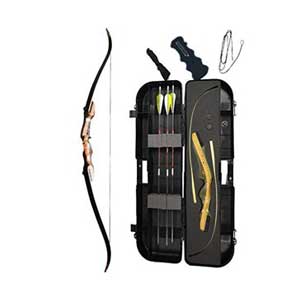
The Samick Sage Ready 2 Shoot, as the name suggests, is an archer kit that incorporates all of the tools you may need, whether you are practicing sports archery or just goofing around in the backyard.
The high-quality riser that is strong enough to support limbs with a draw weight of up to 40 pounds has an ambidextrous orientation so that it can be used by both lefties and righties.
The limbs are also built with premium materials and a huge amount of craftsmanship to give you all the power you may need. But of course, the limbs and the riser aren’t the only parts, the package includes the most critical part too, the string, with a stringer, so you won’t have problems assembling your tool.
So if you are looking for a great package at an excellent price, this recurve bow is the one for you.
Pros
- The high-quality riser that is strong enough to support limbs with a draw weight of up to 40 pounds has an ambidextrous orientation
- The limbs are also built with premium materials and a huge amount of craftsmanship to give you all the power r you may need
- The package includes the most critical part, too, the string, with a stringer so that you won’t have problems assembling your tool
Cons
- While it is pretty sturdy and won’t snap in your hands, the overall quality of the build and the finish makes it pretty lackluster, even if its budget
8. XQMART Recurve
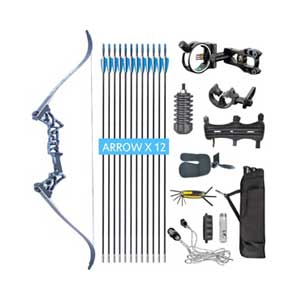
XQMART Recurve is not that much heavier but feels very sturdy and solid in your hands while also being very comfortable to hold, and build tolerances are tight. The riser is nice, well crafted, and solid, made of aluminum; the grip is ergonomically designed and feels comfortable on the hand, even at full draw.
And to top it all off, it has preinstalled bush bearings to make upgrading much easier.
It is very easy to take down and put together for storage, transport, or backyard competition sports games. It is very small when collapsed and fits in a backpack or hiking pack easily. Just keep in mind that using a stringer tool is the safest way to assemble and disassemble the item properly.
The XQMART Recurve shoots consistently, and it is very quiet without anything extra on it, the options for multiple limb weights offer flexibility, arrows fly from the bow blazingly as fast as a compound bow and fly off very smoothly and quietly.
I don’t have particularly anything more to say about this item but that if you want something on the way cheaper side, this is certainly the best choice.
Pros
- XQMART Recurve is not a lot heavier than others but feels very robust and solid in your hands, being very comfortable to hold and build tolerances are tight.
- The grip is ergonomically designed and feels amazingly comfortable on the hand, even at full draw
- It is very easy to take down and put it together for storage, transport, or backyard competition sports games
Cons
- The only major caveat is the fact that it is so widely known as a very good model that there are too many replicas and fakes
9. SAS Spirit Jr 54″
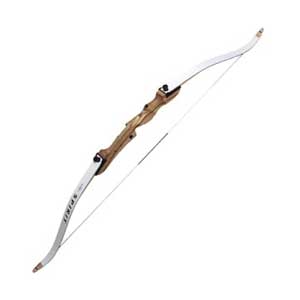
The SAS Spirit is the perfect bow for the youth who desire to discover the pleasure of shooting! They are made of laminated hard maple and strong fiberglass. This will ensure you have the flexibility and longevity your child needs.
This item is going to bend, but it’s going to be hard to break this thing. The riser is made out of three different types of wood. They’re Chuglam, Arborea gmelina, and Beech. These woods give the riser its pale yellow to cream-colored appearance and are made from some of Asia’s most durable trees.
Its riser is crafted from quality European and American solid wood. The limbs, on the other hand, are made of hard maple laminations and strong European fiberglass, both materials allowing said limbs to help the weapon retain its sturdiness, contrary to its large 54 inches size.
While SAS Spirit Jr 54″ doesn’t have a very wide range of draw weights, this doesn’t make it less usable, and in fact, it makes it easier to be used by kids and teenagers alike. And yes, it isn’t that good for hunting, but in my opinion, this takedown bow is a great addition to any beginner archer’s arsenal and is a lot better than a compound bow for anyone who is just getting into the art of archery.
This truly is the best recurve bow for someone looking to get into the world of archery but doesn’t want to spend a lot of money right away.
Pros
- They are made of hard maple laminations and strong fiberglass, ensuring high amounts of flexibility and durability
- The riser is crafted from quality European and American solid wood, giving it a very unique and nice-looking while also strong design
- This truly is the best product for someone looking to get into the world of archery, perfect for beginners
Cons
- While this is definitely a very good product for kids, this doesn’t excuse it for being poorly made and lacking any of the accessories listed
10. Longbowmaker Hungarian
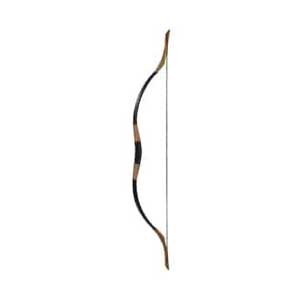
At the end of the list, we have almost squeezed all we can get out of every type of takedown weapon, and the last model is no different. It uses quality materials, has nice packaging and good-looking laminate, but what makes it stand out and what gives it the edge to make it your choice?
One thing. Custom. It can be tailor-made with your draw weight range, your size, and whatever color or material you may want, as simple as that. But even if you don’t utilize this feature, the base model is also pretty good so that you won’t be at a loss there.
Suffice it to say if you want something a little bit different but also not too quirky, you can’t go wrong here.
Pros
- It uses quality materials, and it has nice packaging and good-looking laminate
- It can be tailor-made, with your draw weight range, your size, and whatever color or material you may want, as simple as that
- Even if you don’t utilize the custom-made feature, the base model is also pretty good, so you won’t be at a loss there
Cons
- While it actually has a pretty good custom-making feature, the commercially sold models aren’t that well made to correspond to the listed draw weight
How To Choose The Right Takedown Recurve Bow?
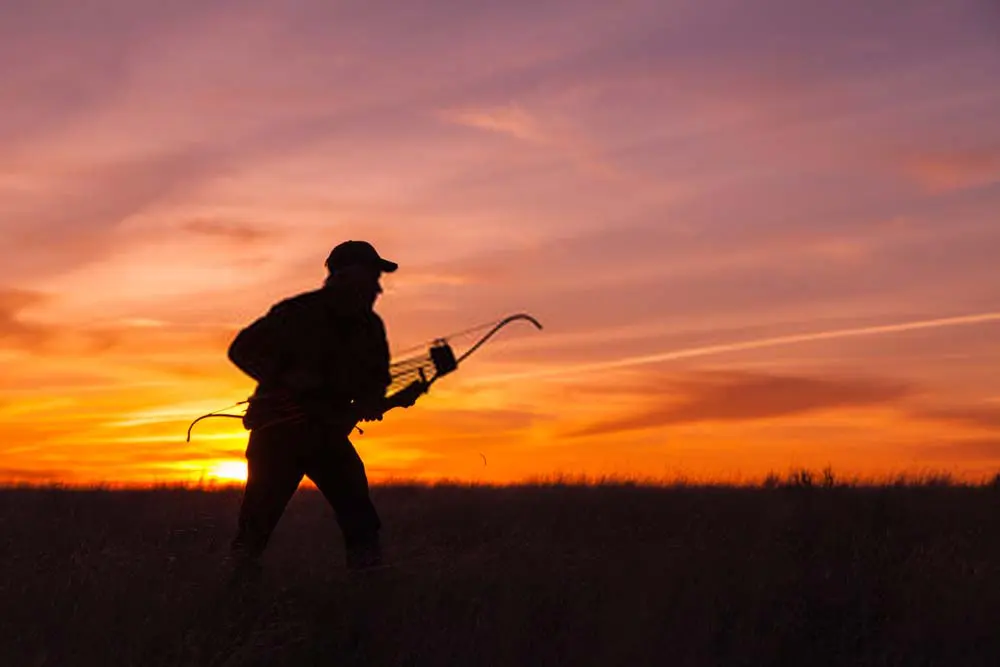
With limbs curved away from the archers when unstrung, the recurve weapon can store a greater amount of energy and is thus able to utilize that energy more efficiently compared to one with straight limbs—the arrow flies faster and with more energy. Choosing the right one comes with knowing what to consider when checking out this kind of equipment.
And let me tell you before we even begin, as a beginner archer, you will want to spend a lot of time searching for the best riser and limbs and the perfect weight balance because, at the end of the day, the weapon is an extension of the Archer’s power and mind, not just a tool.
What Would You Use It For?
For target practice, any recurve one will do fine, even those models for beginners. Choose one that suits your budget or that you personally like. You won’t need to wield an extra powerful weapon for target practice since the arrow will just have to go through the cardboard or foam of the bullseye, and this won’t need a whole lot of energy to achieve.
For hunting, the arrow should be able to penetrate the animal’s thick skin and slip through fat tissue and even the bone of the game animal as well. Any recurve weapon with a draw weight ranging from 40 pounds and up will be great for hunting purposes. There are many options on the market for traditional recurve bows in the 40 pounds and higher range.
For shooting targets, just about any product on the market will do, but when you’re shooting game, such as deer, elk, and turkey, a draw weight of 40 to 45 pounds is ideal. When things heat up with a larger game, such as buffalo, oxen, or grizzly bears, you will want the security of wielding a recurve bow with 55 pounds or more draw weight.
What Is The Optimal Draw Weight?
When choosing the perfect recurve weapon, you must figure out what draw weight you are most comfortable working with. The draw weight denotes the amount of force needed to draw correctly and fully.
Principally, you will have to consider your age, gender, and body weight, along with any physical disabilities or limitations you may have. Beginner archers can build up more strength with time, so they may need to think about their own progressive development instead of being stuck with just body weight as a primary determinant.
Generally, it is recommended that children weighing less than 100 pounds first pick up one with draw weights between 10 and 15 pounds. A draw weight of 25 to 35 pounds should serve well for females with small to medium build. Males with average height should be able to handle draw weights from 40 to 55 pounds.
Draw weight from 40 to 60 pounds may be just what larger men want. To shoot game, you will need nothing lower than 40 pounds, which ensures effective shooting at a safe distance. Should this figure be greater than your recommended range, first go for a draw weight that you can handle comfortably and then work your way from there.
Your draw length refers to the length of your arm span in inches, which is measured from the tip of one middle finger to another with your arms outstretched to both sides and palms facing forward, and then divided by 2.5.
Peg your draw length at a reasonable range since too much will affect your shooting accuracy, form, comfort, and safety during shooting. This will also allow arrows to be trimmed to the proper length to complement your shooting gear.
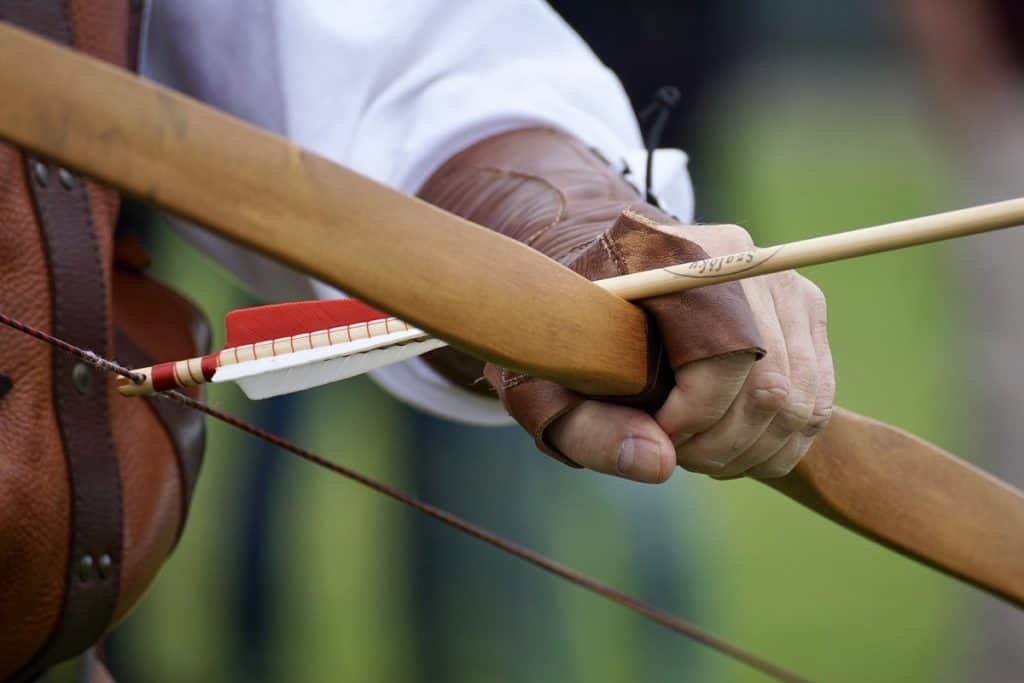
What Are The Most Important Recurve Bow Characteristics?
Aside from its range of draw weights, the recurve bow’s actual weight should also be considered. The most solid ones weigh 2 to 3.5 pounds, which is a safe starting point for beginners.
The weapon`s weight is not as important as the drawing weight, so there’s no pressing need to focus on it. The weapon’s length should be twice as long as your draw length, so if your draw length is 27 inches, you need to get an item of 54 inches or something reasonably longer.
It may take a bit of trial and error to pick the right arrows for you. It is not a huge issue to pick the wrong arrows on your first try. Start with decent-feeling arrows, and after your skill grows, you can choose just the right arrows for you. There are many factors aside from the shooting distance and your experience that could affect the arrows’ response.
What Are The Most Important Recurve Bow Accessories?
Recurve bow packages mostly come with a bare minimum of accessories, which may only include the bow and string. However, many models ship with more than that. Fortunately, you could always make separate purchases for the essential components of your shooting system.
That should include a stringer, arrows and field tips, nocking points, and archery targets for practice. Items such as an armed guard, finger tabs, arrow rest, string wax, and a broadhead wrench can be bought later, but they will still go a long way to ensuring long-term comfort and durability. A quiver, string whisker, and sight are not absolute necessities but should ensure a simple and enjoyable shooting experience.
How To Choose The Right Draw Length For Your Recurve Bow?
Choosing the right draw length is as important as choosing the perfect pair of shoes. The process may not be extremely difficult, but your success at archery depends on getting the draw length correctly.
No matter what kind of bow you have, it is important to measure correctly for a suitable draw length for you, as this also helps you find out the right size and length of arrows you can use as well as the size of your weapon. You do not simply choose one and then fit yourself to it, but you have to fit the bow to your body if you are to shoot consistently.
How To Choose The Proper Size For Your Recurve Bow?
It should not be like learning rocket science to get the right bow size. Recurve bows come in different lengths, and you should not choose a weapon that is extremely long or too short for you as it will affect the accuracy of the shoot. You want a properly sized weapon to avoid physical pain, expensive loss when you miss your target, and an entirely frustrating experience while using.
Assuming that people of the same height have the same draw length is incorrect. There’s no evidence to prove your height equals your arm span. People of the same height will not have the same length as the arm, and their fingers are not the same length either. Furthermore, your age does not determine your proper weapon size.
Age may be used as a guiding factor, but in determining the correct draw length, it is not a primary element to consider, mainly for the same reason mentioned before. Thinking that people of the same age have the same draw length is just like believing that one-size-fits-all pieces of equipment are recurved bows.
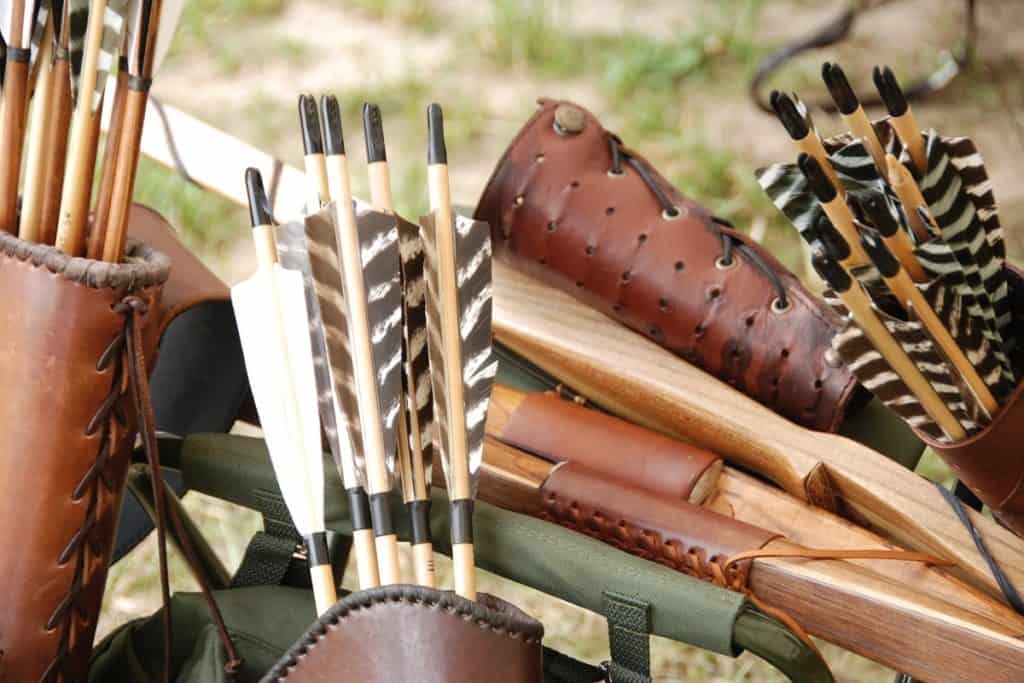
Stretch both of your arms at shoulder level to their respective sides of the body, with the palms facing the front. Do this without stretching in a relaxed manner. Have someone else measure the distance from one middle finger to another middle finger. Divide the number that you obtain by 2.5.
Another way is to divide the result by two and subtract 15 from the number you obtain. Now, you have the calculated draw length, which is going to be very close to your actual draw length. Just get the average between the two calculation methods to make doubly sure, and you would reduce any enormous difference between the two quite a bit. Round off to the nearest half-inch of your calculated draw length.
If you want to be all technical in this regard, you can only use the Archery Trade Association (ATA) method to take the true draw length. The true draw length refers to the distance at your full draw between the nocking point of the string and the pivot point of the grip, plus an extra 1 3⁄4 inches.
This is obtained by drawing the bow to the appropriate anchor position, then having a friend measure from the nock grove or the string apex to the pivot point of the grip. Just add 1 3⁄4 inches to the number that you get, and you should have the correct length of your bow.
For that specific measurement, certain websites provide a table for draw length and the matching size. To make things easier, you can simply refer to the information given on those sites, but it is always better to know how to arrive at an approximate measurement on your own.
It is vital that you can get a reasonable measurement for the length of your weapon since going too short will not give you the level of accuracy you need to shoot. In contrast, going too long will cost you speed and overall performance. Apart from the draw length, you must also determine the correct draw weight for your recurve bow.
This component varies from archer to archer and can be affected by the physical strength, endurance, and coordination of the individual. A draw weight that is too heavy will cause you to develop poor shooting habits, which can be very difficult down the road to correct
Frequently Asked Questions
What Are The Takedown Recurve Bows`Specifics?
Traditional arrows and bows were always a part of human history. Since the time when cavemen realized they could throw their spears only to the extent that their strength would allow it, strings were integrated into the equation to add force and strength to the spear’s velocity, which was later developed into an arrow.
The problem with this device is that the arrow’s distance and strength will depend on the length of the string. The longer the string, the greater the arrow’s trajectory. Of course, the shorter the string, the shorter the distance the arrow will be traveling. Now the length is dictated by the string length.
Because the string should be stretched properly during the rest position, the bow should be long enough to accommodate the same. Imagine tackling a distance of 700 feet if you want to. You would usually need a really, really, REALLY low bow, which can be even longer than your height.
Quite annoying, right?
Fortunately, recurve bows were invented to tackle the problem. They are basically weapons with edges that curve outwards. Usually, the weapon forms an arch that extends away from the body when held by the archers, with the edges curving inward.
A recurve bow is constructed as such, just as the edges do not stop their inward curves. Instead, they curve outward, allowing the strings to draw more mileage.
The Outcome? You have strings that can shoot the arrow at great distances and velocity without requiring a longer weapon. Therefore you would have a more portable tool that is easier to wield.
Since then, it has become the standard equipment for most archery races. For example, in the Olympics, the participant is allowed to carry only a recurve bow. That’s why most archery add-ons are made with this type in mind.
However, this should not be taken as meaning that it is only good for sporting competitions. Outdoor hunting also benefits from the things that bring a recurve weapon to the table for hunting.
Even if the game is many feet away, to ensure the right speed and trajectory, you won’t have to chug along and hefty one. You would have better chances to hit your target with the flexibility it allows while preparing for the strike.
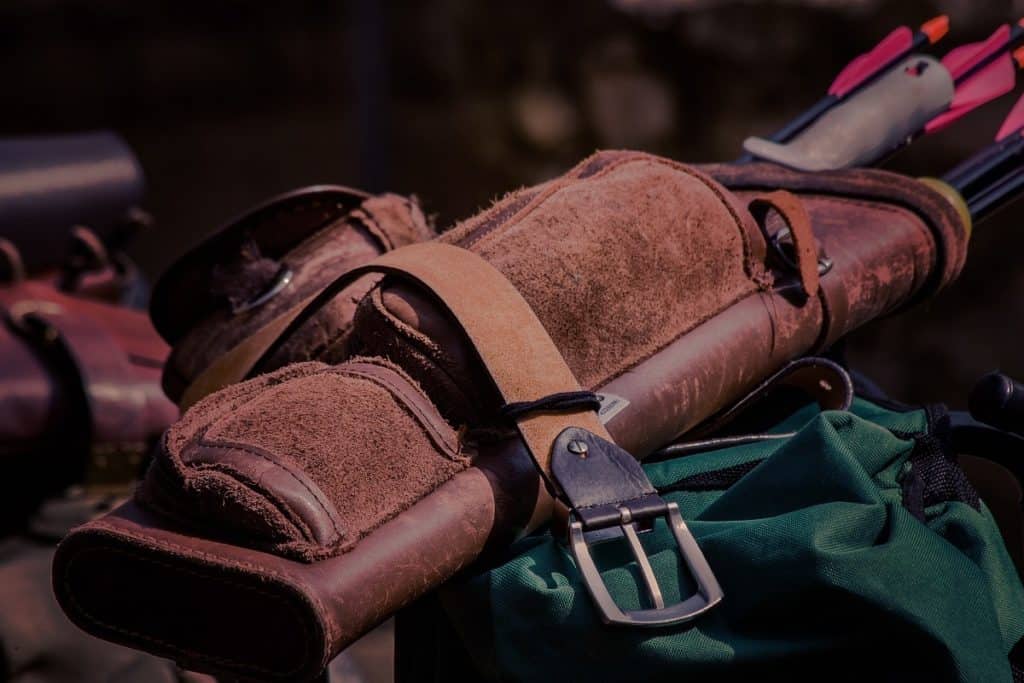
What Elements Would Influence The Draw Length?
When measuring for proper draw length, the top of your shoulders and your weapon’s arm should be correctly aligned. Ensure your shoulders are not in a shrugging position but a low, natural position.
These two elements will ensure that you can get a draw length that isn’t shorter than your actual one. To ensure that the draw length you get won’t be longer than your actual, your neck and head shouldn’t be straining backward while measuring, so just keep them relaxed.
Make sure not to hold the string at an anchor point too far back. Make sure your release aid doesn’t lengthen your draw, either. Observe good posture when measuring and make sure the wrist of your drawing hand is not arched or strained. Don’t use your back muscles when measuring, as this will push your entire shoulder toward your spine, giving you a falsely long measurement.
Beginner archers should not attempt to take their draw length by themselves. It is best to work with a coach or pro-shop expert who can help you measure your draw length properly using a practice bow and a measuring arrow. Remember to stand in good form and alignment during the process.
How To Measure The Draw Length?
Measure from one middle finger to the next with both arms stretched to your sides and your palms facing outwards or to the front. That will be the span of your arm. Then split that measure by 2.5. Another way is to remove 15 from the span of your arm and then divide the difference by two.
The number you get from these methods will be pretty close to an exact measurement. You’ll probably just want to take the average measurement between the two methods and use that number rather than relying on just one method.
Another way to measure the draw length is to take a yardstick to place one end of it on your chest, just down your throat at the point. Extend your arms as far as you can as you clutch your hands before you. Mark the reading you get on your middle finger at the very end and add an extra inch to it to get your rough draw length.
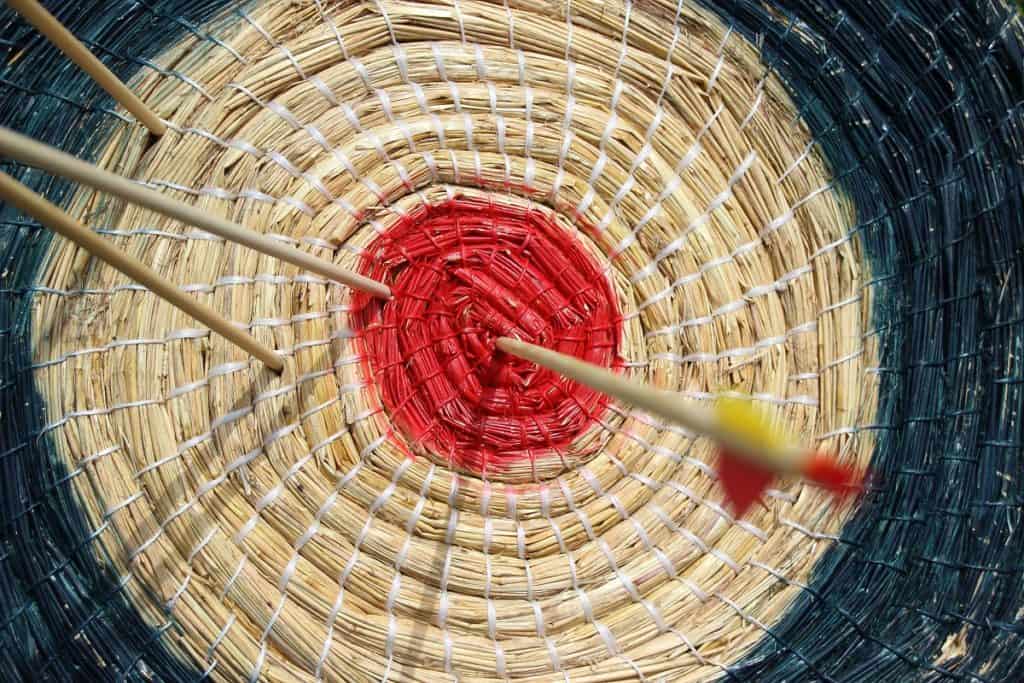
How To Shoot A Recurve Bow?
Assume the proper stance or position. Assume the right position or stance. Stand at a distance that matches the width of your shoulders, with your legs set apart and your whole body, hips, and torso set perpendicular to the target. Right-handed shooters should be standing with the left hip pointing to the target, while left-handed individuals should be standing with the right hip pointing to the target.
Make sure you have one foot on either side of the line of the shoot. The target for right-handed shooters is to the left, and it is to the right for left-handed archers. Keep your body vertical, with your dominant side foot slightly ahead of the other foot, and shooting line at 45 degrees.
Your head should be turned toward your target so you can look at the target directly. Keep your body always perpendicular to your target. Keep your shoulders and chest inside, and don’t hunch your shoulders. Take an arrow, sit on the rest of the arrow, nock it, and lift the weapon to shoulder height. Don’t draw a string when your arrow is nocked.
Make sure your arm is straight and locked to your elbow so that your arm is safe away from it when you release the string. Also, a bent elbow will make it hard for you to draw your strings. To make a gun shape, tuck the pink and ring fingers of your hand into that hand’s palm. Push the inner part of your palm into the grip or the pad of flesh just below your thumb. Keep your knuckles down to the ground at 45 degrees. Your bow hand’s knuckles should all be visible to you.
Use a comfortable yet firm grip to hold the bow. Fortunately, most recurved weapons come with handles, so you don’t have to figure out where to hold the weapon by yourself. Relax the handle on your bow. Do not use a death grip to hold it, as this can lead to a loss of shooting accuracy. Staying relaxed is best for ensuring smooth movement all the way.
Now your fingers should form a hook for your tab hand, with your index finger above the arrow and the middle and ring fingers beneath the projectile. You should relax the pink finger of your tab hand towards the palm of that hand. The top of your index finger and the tab platform should be placed along your jaw for an anchor point.
Draw the string into your nose center. When drawing back, make sure your torso is not twisted to face the target. Make it a habit to let the stronger muscles on your back do most of the work when drawing. Don’t let the bulk of your arm muscles do the job.
Use your dominant eye when aiming while keeping the other eye shut. Using your dominant eye for targeting ensures greater reliability in reaching the goal. If you have a sight or scope on your recurve bow, use the notches in the device to help you line up the target. Check with your eyes for your aim. If you’re sure your arrow points to the target correctly, you’re ready to release the string.
To release the string, let it simply slide out of your fingers. Don’t suddenly release it, nor jerk it up. The string release action should be smooth, and just relax the fingers that hold the string anchored. Allow the string to slide out and drive the arrow to the target with a smooth motion. If you pull on or jerk the string before releasing it, there’s a tremendous likelihood the arrow will fly jerkily, not straight.
Once you release the string, your tab hand should end up behind your neck. Your bow arm should stay firm until after the target has been hit by the arrow. Stay unmoved as long as possible after you release the string and until the arrow strikes the target because a body jerk as soon as the string is released could affect the arrow trajectory negatively.
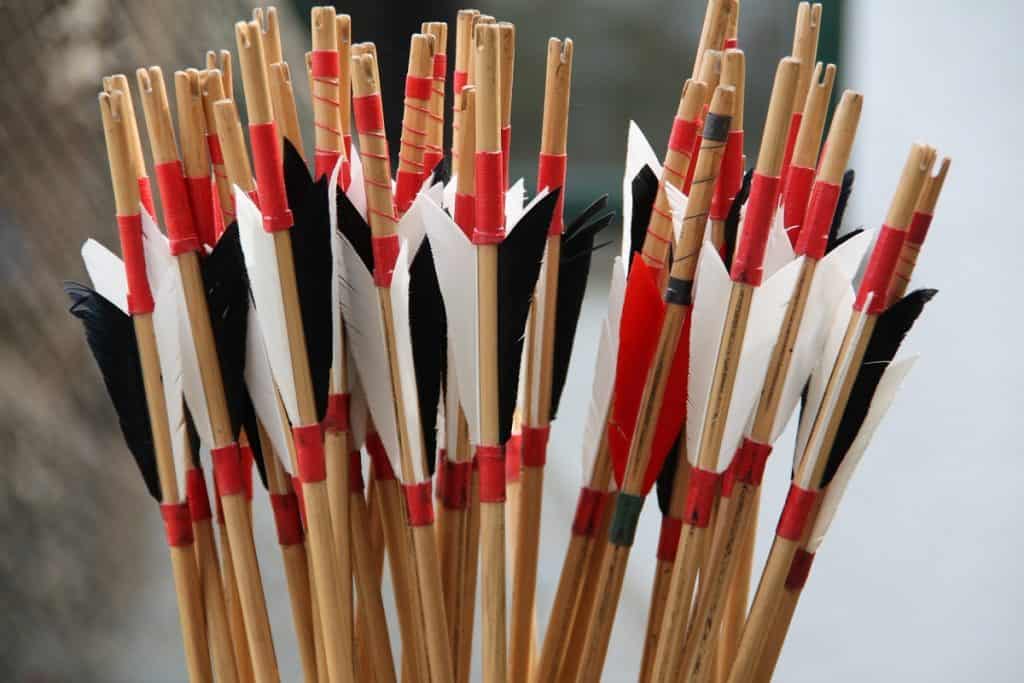
Final Words
In the end, we have looked at some of the best recurve bow models that the market can offer right now, some with premium quality fiberglass limbs and machined aluminum riser, some made for users who are just beginning, and some that are made to give you as much performance as a compound one without making you spend a fortune.
I’m not the one to tell you that there are a lot of models that users need to choose from, and choosing the overall best one is really dependent on the task they will be using it for, and on the amount of money they are willing to spend.
Usually, the recurved weapons are preferred for their much simpler construction compared to their compound counterparts, but they have just as many fine details that you will be searching for when you are looking for the best model for you.
